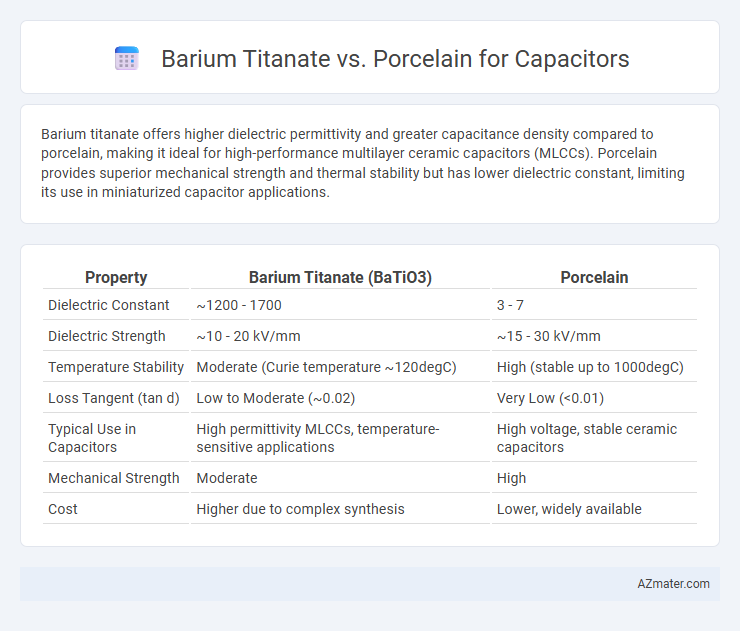Barium titanate offers higher dielectric permittivity and greater capacitance density compared to porcelain, making it ideal for high-performance multilayer ceramic capacitors (MLCCs). Porcelain provides superior mechanical strength and thermal stability but has lower dielectric constant, limiting its use in miniaturized capacitor applications.
Table of Comparison
| Property | Barium Titanate (BaTiO3) | Porcelain |
|---|---|---|
| Dielectric Constant | ~1200 - 1700 | 3 - 7 |
| Dielectric Strength | ~10 - 20 kV/mm | ~15 - 30 kV/mm |
| Temperature Stability | Moderate (Curie temperature ~120degC) | High (stable up to 1000degC) |
| Loss Tangent (tan d) | Low to Moderate (~0.02) | Very Low (<0.01) |
| Typical Use in Capacitors | High permittivity MLCCs, temperature-sensitive applications | High voltage, stable ceramic capacitors |
| Mechanical Strength | Moderate | High |
| Cost | Higher due to complex synthesis | Lower, widely available |
Introduction to Capacitor Dielectric Materials
Barium Titanate and Porcelain represent two distinct capacitor dielectric materials with unique electrical properties. Barium Titanate, a ceramic perovskite, exhibits high dielectric constant and excellent ferroelectric characteristics, making it ideal for high-capacitance, small-size capacitors. Porcelain, composed mainly of kaolin and feldspar, offers high mechanical strength and thermal stability but typically lower dielectric constant, which suits applications requiring robust insulation and moderate capacitance.
Overview of Barium Titanate
Barium titanate is a ferroelectric ceramic material widely used in capacitors due to its high dielectric constant, allowing for greater energy storage in a compact size compared to porcelain. Its perovskite crystal structure contributes to excellent dielectric properties, including high permittivity and tunable capacitance, making it ideal for multilayer ceramic capacitors (MLCCs) and temperature-sensitive applications. Unlike porcelain, which offers mechanical strength and thermal stability, barium titanate enables superior electrical performance in electronic components requiring high capacitance and low loss.
Characteristics of Porcelain in Capacitors
Porcelain capacitors exhibit high thermal stability and exceptional mechanical strength, making them durable under varying environmental conditions. Their low dielectric constant results in lower capacitance values compared to barium titanate capacitors, but they offer excellent insulation resistance and minimal dielectric absorption. Porcelain's rigid ceramic structure provides superior vibration resistance, ideal for applications requiring long-term reliability and stable performance.
Dielectric Constant Comparison
Barium Titanate exhibits a significantly higher dielectric constant, often ranging between 1,000 and 10,000, compared to porcelain's dielectric constant, typically around 5 to 10. This substantial difference makes Barium Titanate a preferred material for capacitors requiring high capacitance and miniaturization. Porcelain, with its lower dielectric constant and higher mechanical strength, is more suitable for applications demanding durability over volumetric efficiency.
Temperature Stability: Barium Titanate vs Porcelain
Barium Titanate offers exceptional temperature stability due to its high dielectric constant and ferroelectric properties, maintaining capacitance over a broad temperature range. Porcelain capacitors exhibit moderate temperature stability but generally have lower dielectric constants, resulting in less consistent performance under thermal variations. This makes Barium Titanate superior for applications requiring reliable capacitance in fluctuating or high-temperature environments.
Electrical Strength and Insulation Resistance
Barium Titanate exhibits higher electrical strength and dielectric constant compared to porcelain, enabling capacitors to achieve greater energy storage within a smaller volume. Its superior insulation resistance reduces leakage currents, enhancing capacitor reliability in high-voltage applications. Porcelain, while offering adequate insulation resistance, typically falls short in electrical strength, limiting its use in compact, high-performance capacitors.
Applications in Modern Electronic Devices
Barium Titanate is favored in multilayer ceramic capacitors (MLCCs) due to its high dielectric constant and excellent temperature stability, making it ideal for compact, high-capacitance applications in smartphones, laptops, and automotive electronics. Porcelain capacitors, though less common, offer superior mechanical strength and reliability in high-voltage and high-frequency applications, often found in specialized industrial and aerospace electronics. The choice between Barium Titanate and Porcelain capacitors depends on the specific electronic device's requirements for capacitance density, temperature performance, and voltage endurance.
Cost-Effectiveness and Manufacturing Considerations
Barium titanate offers superior dielectric constants compared to porcelain, enabling smaller capacitor sizes at higher capacitance values, which enhances cost-effectiveness by reducing material usage and assembly complexity. Manufacturing barium titanate capacitors involves precise ceramic processing and doping control to achieve optimal performance, whereas porcelain capacitors benefit from simpler firing processes but yield lower dielectric efficiency. The trade-off between initial material costs and performance gains makes barium titanate preferable for high-performance applications, while porcelain remains a budget-friendly choice for standard capacitors with less stringent dielectric requirements.
Environmental Impact and Longevity
Barium Titanate capacitors demonstrate strong longevity due to their high dielectric constant and thermal stability, resulting in extended operational life and reduced waste. Porcelain capacitors offer superior environmental benefits by utilizing natural materials with lower toxicity and easier recyclability, minimizing ecological footprint during disposal. Choosing between Barium Titanate and Porcelain capacitors involves balancing the longer lifespan of Barium Titanate with the enhanced sustainability profile of Porcelain-based components.
Conclusion: Selecting the Optimal Dielectric Material
Selecting the optimal dielectric material between barium titanate and porcelain hinges on the specific capacitor application requirements, with barium titanate excelling in high dielectric constant and temperature stability, making it ideal for high-capacitance, precision components. Porcelain offers superior mechanical strength and higher insulation resistance, suited for robust, high-voltage insulators. Balancing dielectric constant, breakdown voltage, thermal stability, and mechanical durability is crucial for achieving the best capacitor performance.

Infographic: Barium Titanate vs Porcelain for Capacitor
 azmater.com
azmater.com